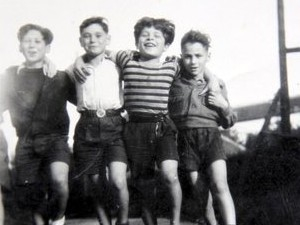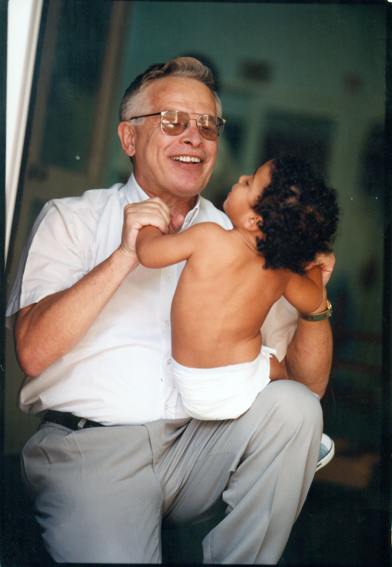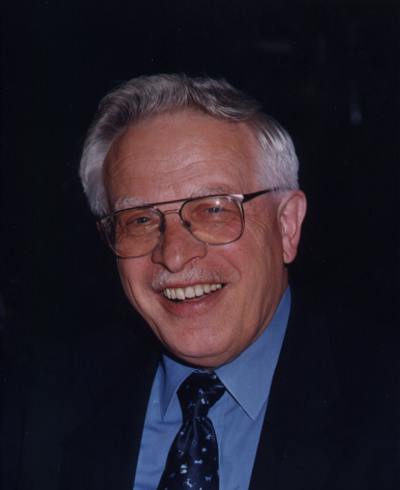Shaul Harel was born Charlie Hilsberg in Brussels, Belgium in 1937, the youngest of five children. His father was a haberdasher and a Cantor, distinguished for his particularly beautiful voice. A happy childhood and formal education were irrevocably and brutally disrupted at age five. In the first stage of Nazi occupation of Belgium his oldest brother volunteered to do agricultural work in Germany with the promise that this would save further trouble to his family.
He was sent to Auschwitz. The deportation and deaths of Shaul's parents and his becoming one of the "hidden children" followed. Dr. Harel has recently and deeply movingly commemorated his experiences under the care of Andrée Geulen (known to "her children" merely as Mademoiselle). She was a leader of a network of individuals who risked their own lives to protect these "hidden children."
The commemoration consists of a film and the writing recently recorded song. The song's recollections include Mademoiselle's extraordinary bravery in responding to the ugly and imminent threats made to Charlie and other small Jewish children by a German soldier who said he could not believe that an Aryan woman could protect them: She responded "Comment vous, les descendants de Goethe et Schiller, n'avez pase honte de faire la guerre contre des enfants innocents?" For the confused and despairing child that was to become Dr. Harel this woman "brought the smile back to my face." It is a gift that Dr. Harel has repaid countless times subsequently in return. As he frequently observes "to put a smile on the face of a child makes my day." He has instilled the love of this reward and the manner of achieving it with a child in the many students, residents, and colleagues with whom he has associated in his long career.
Dr. Harel left Belgium for Israel at 12 years of age, in 1949. He adopted, as was customarily urged, the Israeli name, Shaul Harel. Dr. Harel fought in the Sinai War of 1956 and was seriously injured. Despite his interrupted formal education, he was able to attend the Hebrew University School of Medicine. Very interested in the neurological development of infants, he wrote his thesis on minimal brain dysfunction. As a family doctor and pediatrician, he first practiced in a remote city of Southern Israel. His work was interrupted by service as physician in the 1967 War. He met and got on well John Menkes in Jerusalem and was invited to train in neurology and pediatrics at UCLA.
From the start of his training he became involved in research, employing a rabbit model in order to study the effects of intrauterine growth retardation on brain development. His results were published in 1972 as the first of 106 ensuing full-length publications. It remains his most highly cited (124 times), though more than 50 of his papers have had quite significant numbers of citations. His training and his laboratory work were interrupted by the Yom Kippur War of 1973 because of which he returned to his rank of Major for two months in active service as a physician. His wife Dalia in the meantime cared for their three children in California worrying and awaiting his return. Of his wife Dr. Harel has observed "she was the real hero." His family, residency position, laboratory, and salary were carefully protected by Joe Van Der Meulen, Chair of Neurology at USC in exchange for Dr. Harel's promise "to keep his head down when under fire." Upon his return to America Dr. Harel completed his neurology training as well as a special fellowship in Child Development including a travel fellowship that permitted him to review throughout the United States methods of follow-up for high risk infants. He was able to apply what he had learned upon his return to Israel in 1975. He took up practice at the University of Tel Aviv—the start of what would be many years of devoted, intelligent, and constructive service. He was aware and appreciative of the pioneering work that Dr. Naomi Amir had done in the establishment of care for children with neurological disabilities.
Upon his return to America Dr. Harel completed his neurology training as well as a special fellowship in Child Development including a travel fellowship that permitted him to review throughout the United States methods of follow-up for high risk infants. He was able to apply what he had learned upon his return to Israel in 1975. He took up practice at the University of Tel Aviv—the start of what would be many years of devoted, intelligent, and constructive service. He was aware and appreciative of the pioneering work that Dr. Naomi Amir had done in the establishment of care for children with neurological disabilities.
He wished to broaden and enrich the nature of such practice. He initiated well-baby clinics and early-recognition/intervention neurodevelopmental evaluation and remediation programs. He established the Institute for Child Development and Pediatric Neurology, serving as Chief for nearly 40 years. He became a valued participant in the National Scientific Council of Israel. At the same time his wife Dalia became an highly valued participant in the development of the national agricultural councils and programs of Israel, at which she has worked tirelessly for many decades.
Since 1969, Dr. Harel has been a teacher and mentor for medical students, physicians in practice, therapists and nurses. He has exerted exemplary concern over the quality of the scientific and clinical education of child neurologists and neurodevelopmentalists. His guidance and nurturing have been enriched by the fact that he has been an extraordinarily role model. He has nurtured those in training during their moments of career indecision and other stresses that common during the interval of professional training. He was the driving force behind the development of training and certification programs in Israel for child neurology and developmental pediatrics.
He has exemplified, sine qua non, the manner in which history and examination of children may best be performed and he has done the same as a model of clear and deliberative thinking, calm determination to do the right thing. He has remained unfailingly an exemplar of an attitude of respect for patients and colleagues alike. Upon his return to Israel he resumed his work on the basic science of perinatal brain injury and of brain development employing a canine model, work that in continuation with his work on rabbits has proceeded uninterrupted for decades. His basic science has proceeded in tandem with clinical science, particularly large-scale longitudinal neurodevelopmental studies particularly of human infants with intrauterine growth retardation. His basic and his clinical research has received continuous grant support from 1975 to the present.
His activities in international presenting research to international symposia started in 1973 in Italy and have continued in an uninterrupted fashion to the present. His association with the CNS started with his attendance at the second meeting of the Society in 1973. Very early in his career, Dr. Harel graduated from being a sought-after speaker at such meetings to the assumption of the responsibility for organizing them. He was elected to the Executive Board of the International Child Neurology Society in 1976, serving continuously since that time. H was Chair and President of the ICNA World Congress in Jerusalem in 1986.
He was elected Chair of the Israel Pediatric Neurology Society in 1986. He co-founded the Mediterranean Child Neurology Society in 1986 and served as President of the 3rd Meeting of the Society in 1989. He was Chairman of the 1st International Symposium on Pediatric Neurosurgery and Neurology in Tel Aviv in 1990 as well as a Co-Chairman of the 5th International Child Neurology.Asian/ Oceanian Congress in Tokyo in that same year. He served as Sectretary General of ICNA from 1994-98. He President of the first Congress of European Pediatric Neurology Society meeting in 1995. He was on the Planning Committee of the 17th World Congress of Neurology in 1999. He was invited to become a Fellow of the Royal Society of Medicine in 1999.
Dr. Harel has devoted himself to the clinical and scientific characterization of the transition from prenatal to postnatal life. In addition to his 106 full length original papers, he has published 25 case reports, 6 review articles, and 26 book chapters. He has edited five books including a textbook on child neurology for which his co-editors were Joseph French and Paul Caesar. . He has delivered 95 invited papers at scientific meetings and 141 submitted ones. More than twenty highly cited papers characterize the mechanisms of brain injury individuals with intrauterine growth retardation (IUGR), including those associated with partial ischemic and other deleterious episodes as well as the clinical manifestations of the effects of the various forms of brain growth impairing stresses. 
The various patterns of resulting dysfunction that problems may experience with intellectual and other cerebral functions are meticulously characterized. His investigations consider as well the manner in which combinations of such dysfunctions constitute what he has termed disturbed functional coherence in every day life. With his colleagues he has demonstrated the variation in effects of the timing of IUGR, the late variety associated particularly with frontal lobe network dysfunction. He has similarly subdivided and characterized the memory deficits of children with IUGR. He has characterized velocity curves for brain growth under various experimental conditions.
Dr. Harel has demonstrated repeatedly that the cephalization index (ratio of head circumference to weight at birth) is the best single indicator on physical examination of risk for such dysfunctions on long-term followup. He has provided and validated other more detailed indices of risk such as the neonatal risk score. Other studies consider the value of assessment of infantile movement patterns, visual function, and other indices of development. He has provided this and other information in order to assure identification and early intervention, individualized according to deficit profile, in order to improve outcome. He has investigated problems in other organ systems associated with IUGR, such as renal glomerular developmental abnormalities and neuroendocrine dysfunction..
His work on the epidemiology of childhood epilepsy is also highly cited, as are his considerations of the metabolic effects of chronic anticonvulsant treatment of epilepsy, the risk for unprovoked seizures after complex febrile convulsions, and that the risk for epilepsy is low in children with developmental disabilities unless they also manifest cerebral palsy or mental retardation. Other large and carefully executed studies consider such varied topics as the manifestations of mitochondrial disorders, clinical categorization of chronic headache, neurocutaneous disorders, treatment approaches to cerebral palsies, neuromuscular conditions, autism, alternating hemiplegia, movement disorders, sleep disturbances, ataxias, neuro-oncology, and a variety of heritable metabolic diseases.
Dr. Harel was invited to participate in a Vatican-sponsored "Seminar on Peace and Human Rights" in 2000 that was intended to encourage Muslim, Chirstian, and Jewish individuals to meet together to understand and respect one another. For his contributions to this effort, Dr. Harel was personally received by the Pope in Rome. Dr. Harel organized in 2007 a conference in Jerusalem concerning "Children Hidden in Belgium During the Holocaust." The motto of this conference was Santayana's: "Those who forget the past are condemned to repeat it." The conference was aimed not only at commemoration, it was aimed at respect and understanding for the resilience of children, the nobility and sacrifice of those who wish to protect them at whatever risk.
Dr. Harel's abundant virtues and his many contributions have received considerable recognition, including that of a grateful Israeli Ministry of Health in 2001. In 2010 he received a special award from the Israel Society for Child Development for Lifetime Achievements in contributing to and promoting child development. In 2011 Dr. Harel received the Arnol Gold Award for Humanism in Medicine from the Child Neurology Society. But it is likely that to him, the greatest honor involves the manner in which the countless children he has cared for over his long career readily, trustingly, and without reservation embrace his friendship and caring attitude. He meets them eye-to-eye with mutual respect as he does their parents, regardless of their ancestry or religion.
He did so without distinction on the basis of the socioeconomic status of children and families, devoting himself for four decades to the cause of the rights of children to high quality and readily accessible health care. He has a warm and engaging personality and an excellent sense of humor. He nourishes the hope that the day will come when Israeli-Palestinian cooperation will nourish the development of an ever greater institution for clinical and scientific undertakings that will serve the needs of all children of the region.
Professor Dr.Harel exemplifies a quite remarkable quality of resilience and hopefulness, of appreciation for what is best in the human soul and in the human willingness to help others. He does so despite exceptional knowledge of what can go wrong and be wrong in human behavior. He has Madame Montessori's sense that his job is to find the little embers in children and blow on them until they burn brighter. His science has been intended not only to do this, but to find ways of preventing those things that impair the function of those little embers. He clearly would like to improve many other things in the world—to make them better, to do what is fair and right.
He has the capacity to demonstrate and prove what is right by the elicitation of a child's smile and the corresponding and immediate elicitation of warmth in his own good heart—two highly complex neurological reflexes that place all else in life in perspective. They are forces that fuel the hope that such reflexes somehow engender more widespread human understanding and appreciation of each other, the desire to work hard for the welfare of each other. He knows better than most how bitter and ugly life may be. But his experiences have not made him less hopeful that human nature is capable of being better than it knows.
The moving story of Professor Shaul Harel’s life from darkness to light, from Holocaust survivor to world expert in pediatric neurology and child development is currently available on Amazon.